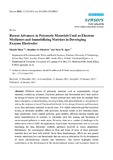Please use this identifier to cite or link to this item:
https://cris.library.msu.ac.zw//handle/11408/1543Full metadata record
| DC Field | Value | Language |
|---|---|---|
| dc.contributor.author | Moyo, Mambo | - |
| dc.contributor.author | Okonkwo, Jonathan O. | - |
| dc.contributor.author | Agyei, Nana M. | - |
| dc.date.accessioned | 2016-06-09T13:39:01Z | - |
| dc.date.available | 2016-06-09T13:39:01Z | - |
| dc.date.issued | 2012 | - |
| dc.identifier.issn | 1424-8220 | - |
| dc.identifier.uri | http://www.mdpi.com/1424-8220/12/1/923 | - |
| dc.identifier.uri | http://hdl.handle.net/11408/1543 | - |
| dc.description.abstract | Different classes of polymeric materials such as nanomaterials, sol-gel materials, conducting polymers, functional polymers and biomaterials have been used in the design of sensors and biosensors. Various methods have been used, for example from direct adsorption, covalent bonding, crossing-linking with glutaraldehyde on composites to mixing the enzymes or use of functionalized beads for the design of sensors and biosensors using these polymeric materials in recent years. It is widely acknowledged that analytical sensing at electrodes modified with polymeric materials results in low detection limits, high sensitivities, lower applied potential, good stability, efficient electron transfer and easier immobilization of enzymes on electrodes such that sensing and biosensing of environmental pollutants is made easier. However, there are a number of challenges to be addressed in order to fulfill the applications of polymeric based polymers such as cost and shortening the long laboratory synthetic pathways involved in sensor preparation. Furthermore, the toxicological effects on flora and fauna of some of these polymeric materials have not been well studied. Given these disadvantages, efforts are now geared towards introducing low cost biomaterials that can serve as alternatives for the development of novel electrochemical sensors and biosensors. This review highlights recent contributions in the development of the electrochemical sensors and biosensors based on different polymeric material. The synergistic action of some of these polymeric materials and nanocomposites imposed when combined on electrode during sensing is discussed. | en_US |
| dc.language.iso | en | en_US |
| dc.publisher | MDPI | en_US |
| dc.relation.ispartofseries | Sensors;Vol.12; p. 923-953 | - |
| dc.subject | Polymeric material; mediator; electrochemical sensor; biosensor; enzyme electrode | en_US |
| dc.title | Recent advances in polymeric materials used as electron mediators and immobilizing matrices in developing enzyme electrodes | en_US |
| dc.type | Article | en_US |
| item.fulltext | With Fulltext | - |
| item.grantfulltext | open | - |
| item.openairecristype | http://purl.org/coar/resource_type/c_18cf | - |
| item.languageiso639-1 | en | - |
| item.openairetype | Article | - |
| item.cerifentitytype | Publications | - |
| Appears in Collections: | Research Papers | |
Files in This Item:
| File | Description | Size | Format | |
|---|---|---|---|---|
| sensors-12-00923.pdf | Full Text | 628.67 kB | Adobe PDF |  View/Open |
Items in MSUIR are protected by copyright, with all rights reserved, unless otherwise indicated.



